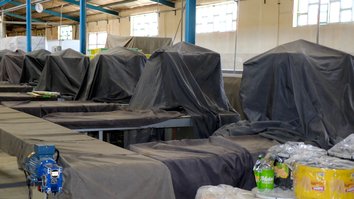KARACHI -- The arrest of four suspected members of a local al-Qaeda offshoot in Karachi is being hailed as a major success as Pakistani authorities continue operations to squash terrorists' efforts to regroup in the country.
Karachi Police's Special Investigation Unit (SIU) and federal intelligence agencies carried out a joint raid on April 19 in the Gulistan-e-Johar neighbourhood, arresting four militants belonging to al-Qaeda in the Indian Subcontinent (AQIS), said SIU Senior Superintendent Irfan Bahadur.
"The arrested militants were identified as Muhammed Umer, Muhammed Bilal (alias Fida), Muhammed Waseem and Muhammed Amir," he said, adding that all four had undergone training in Afghanistan.
The arrested militants had conducted reconnaissance on certain sensitive locations for future attacks, including the Pakistan Stock Exchange, City Courts, and the Police Training Centre, he said.
![Police January 22 take part in training at a Karachi training centre. The AQIS militant suspects whom police arrested April 19 in Karachi are accused of planning to attack the police training centre and other government buildings. [Zia Ur Rehman]](/cnmi_pf/images/2020/04/28/23699-pf_aqis_2-585_329.jpg)
Police January 22 take part in training at a Karachi training centre. The AQIS militant suspects whom police arrested April 19 in Karachi are accused of planning to attack the police training centre and other government buildings. [Zia Ur Rehman]
"Police seized the weapon cache they had stockpiled to carry out terrorist attacks in the metropolis," he said.
AQIS on steady decline
Pakistan's crackdown on militancy and terrorism have greatly degraded AQIS's presence in the country.
The killing of AQIS chief Asim Umar in Afghanistan last September 23 was considered a major blow to the terrorist group in the region and highlighted joint efforts by Afghan, Pakistani and coalition forces to prevent the return of the terrorist group.
Umar had led AQIS from its inception in 2014.
Afghanistan's National Directorate of Security (NDS) last October 8 confirmed Umar's death on Twitter, adding that among six other AQIS members killed in the raid was a man identified as a courier for al-Qaeda leader Ayman al-Zawahiri.
"Muhammad Hanif, alias Zarar, was made new chief of AQIS after Umar's killing," Bahadur said.
Hanif, who now lives in Afghanistan, is originally from Karachi and was one of the founders of the AQIS network when he was in the city, he said.
Soon after the group's formation, AQIS became active in Pakistan and several local militant outfits that had an ideological association with al-Qaeda also pledged allegiance to AQIS.
Just months after its formation, AQIS attempted to hijack a Pakistani navy frigate in Karachi in September 2014. The attack killed 10 paramilitary personnel and wounded 15, while two attackers were killed in the ensuing fighting, and a third blew himself up.
Over the past two years, law enforcement agencies have continued to crack down on AQIS, shattering its network.
In November 2018, Karachi Police arrested suspected AQIS leader and close al-Zawahiri aide Umar Jalal Chandio alias Khatio in the Gulshan-e-Iqbal area. He is still in custody.
Meanwhile, in a shootout last June, Karachi Police killed Talat Mehmood, alias Yousaf, the AQIS chief for Sindh Province, along with three of his colleagues.
The Punjab Police Counter Terrorism Department (CTD) last December busted an AQIS media cell in Gujranwala, arresting five men suspected to be important members of the terrorist group.
The CTD seized a large quantity of media equipment, funds, suicide jackets, explosives, and arms in the terrorists' possession.
Afghanistan no longer safe haven
After the launch of counter-insurgency Operation Zarb-e-Azb in Pakistan in 2014, most AQIS militants fled to Afghanistan, where the Afghan Taliban have long sheltered al-Qaeda leaders.
But the killing of Umar and of other top leaders, such as Harkat-ul-Jihad-al-Islami leader Qari Saifullah Akhtar in January 2017 and AQIS second-in-command Omar Khetab in December 2017, shows that Afghanistan is no longer a safe haven for al-Qaeda or its South Asian affiliate.
In March 2019, a military offensive in Gero District, Ghazni Province, Afghanistan, killed more than 30 AQIS militants, including several would-be suicide bombers.
AQIS suffered another blow after the Afghan Taliban and the United States inked a peace agreement in February in Qatar, analysts say.
The Afghan Taliban agreed to prevent any group or individual, including al-Qaeda, from using Afghan soil to threaten the security of the United States and its allies, according to the agreement.
"Al-Qaeda launched AQIS in the region in September 2014 mainly to counter the 'Islamic State of Iraq and Syria' (ISIS), which launched its Khorasan branch two months earlier," said Munir Ahmed Shah, a Karachi-based journalist researching militant groups.
Six years after its formation, AQIS has disintegrated in Pakistan and Afghanistan, he said. "The killings and arrests of its leaders show that the region no longer provides a safe place for it."
In another sign that AQIS is turning away from Afghanistan and Pakistan, the group announced that it was changing the name of its Urdu publication from "Nawa-e-Afghan Jihad" to "Nawa-e-Ghazwa Tul Hind".
"It clearly shows the geographical shift of AQIS, which has now planned to shift its focus to India and the turbulent Kashmir territory," Shah said.

![Karachi police on April 22 perform security duties. In a raid on April 19 in the Gulistan-e-Johar area, police arrested four suspected AQIS militants. [Zia Ur Rehman]](/cnmi_pf/images/2020/04/28/23698-pf_aqis_1-585_329.jpg)







Good work. i like this Artical
Reply2 Comment(s)
good
Reply2 Comment(s)